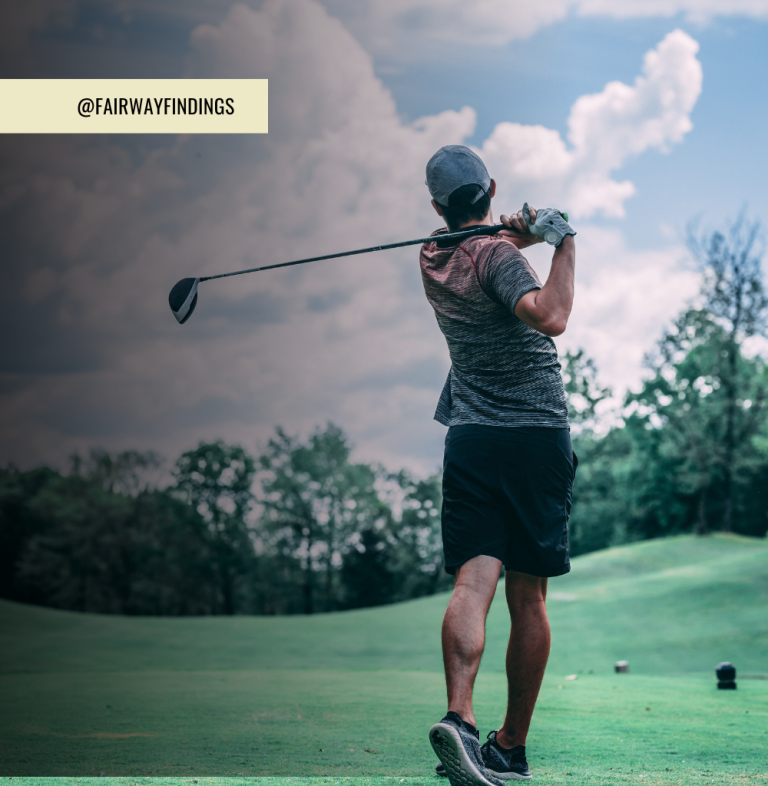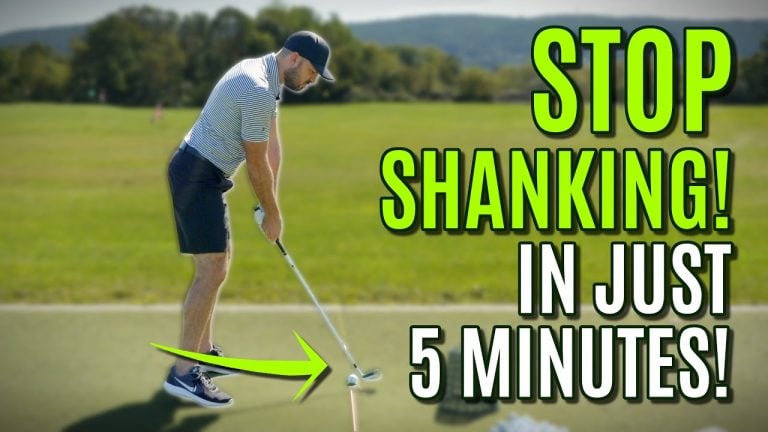Gripping Success: Mastering the Art of How to hold a golf club
Key Takeaways:
- A proper golf grip is crucial for effective swinging and ball striking, and can help fix a slice and increase consistency.
- Evaluating your current grip is the first step towards improvement. Consider grip size, hand size and shape, and utilize grip trainers to refine your technique.
- There are different types of grips to choose from, including the interlocking grip, overlapping grip, and baseball grip, each with their own advantages and potential drawbacks.
- Grip strength and pressure play a role in shot control and club head speed. Find the optimal grip pressure and maintain a relaxed grip to achieve a smooth swing.
- Adjusting your grip can help address ball flight issues such as a slice or hook. Understand the impact of grip on the club face angle at impact and make necessary adjustments.
- There is no perfect grip, but it should be compatible with your individual technique, release, and desired ball flight. Experiment with grip variations and adapt for different clubs and shot types.
- Additional considerations for holding a golf club include the role of the left thumb, techniques for changing the grip and improving posture, and the benefits of beginner lessons for further improvement.
- A proper golf grip enhances all aspects of the game and applying the MECE framework to other golfing fundamentals can lead to overall improvement.
The Importance of a Proper Golf Grip
A solid golf grip is the foundation for successful swings and accurate ball striking. Discover the significance of a proper grip and how it can enhance your game. From fixing slices to improving consistency, we’ll explore the ways in which the grip can transform your performance.
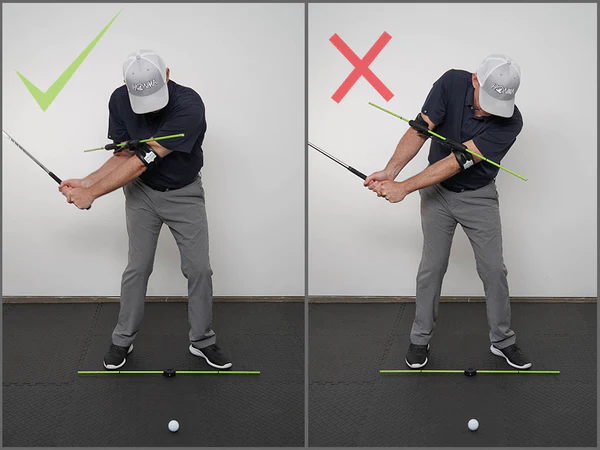
Renowned golf coaches have long emphasized the importance of a correct grip and stance, supporting the notion that mastering this fundamental element is key to unlocking your full potential on the green.
Why a proper grip is crucial for effective swinging and ball striking
A proper grip is essential for successful golfing. It affects accuracy, consistency, and power of shots. The grip controls the clubface angle at impact, allowing players to direct the ball. Great coaches emphasize grip since it forms the base for a strong swing action.
By mastering the grip, golfers can improve their skill to hit the ball accurately and gain better results. Moreover, a proper grip can also fix common issues like slices and hooks, leading to more consistent shots.
Evaluate your grip to begin improving. Look at factors like grip size based on hand shape and available options to enhance performance. Different hand positioning techniques and grip trainers can also help refine the grip technique.
Golfers can experiment with different types of grips to find the right one. The interlocking grip offers stability and control, but can bring tension to some individuals. The overlapping grip is popular among beginners as it offers a secure hold. However, it may limit wrist movement for experienced players. Lastly, the baseball grip offers simplicity but may lead to weaker control over shots.
Grip strength and pressure are important to achieve desired shot outcomes. Knowing different levels of grip strength helps optimize shots, controlling club head speed and generating power. A relaxed grip lets a smoother swing motion and better performance.
Adjust your grip to fix ball flight problems, such as slices or hooks. Videos demonstrating grip adjustments for specific shots can give visual guidance. Although there is no perfect grip for everyone, finding one that fits individual technique and desired ball flight is important.
Experimenting with grip variations and relying on ball flight as feedback helps players fine-tune the grip. Also, adapting the grip to different clubs and shot types ensures versatility in a golfer’s game.
Other aspects of holding a golf club include the role of the left thumb in controlling the club and techniques for changing the grip while improving posture. Beginner lessons can be helpful in further refining grip technique and other basics of the golf swing.
Get a grip! Fix your slice and avoid the embarrassment of losing balls.
How the grip can fix a slice and increase consistency
A proper golf grip is essential for fixing a slice and improving your ball striking. It helps you control your shots and get consistent results. Great coaches know that mastering the grip is key for a good swing.
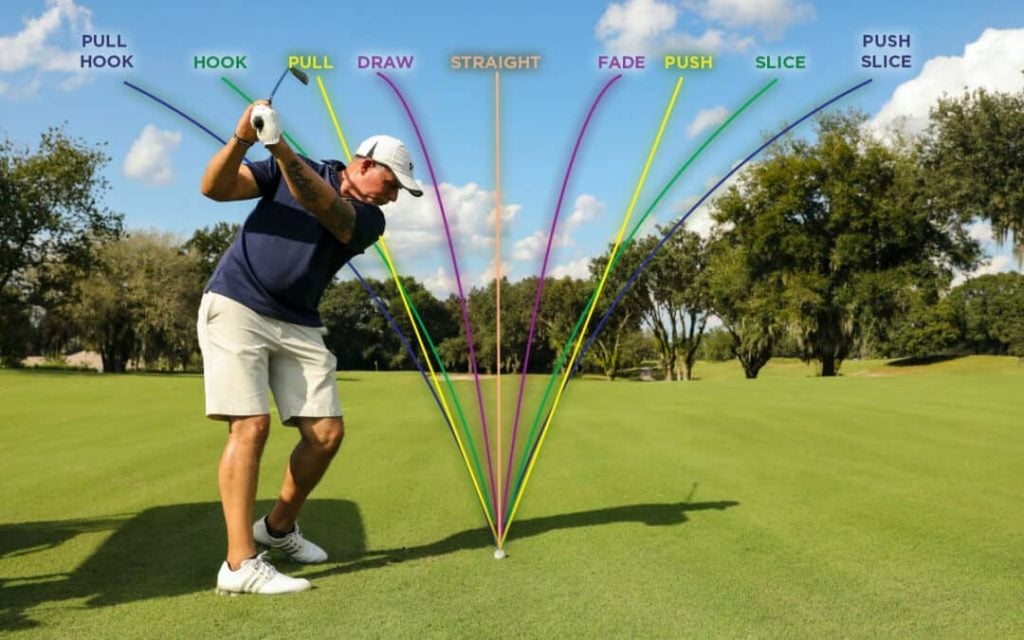
Here are 3 steps to fix a slice and improve your game:
- Check your current grip. Examine the size, shape and positioning of your hands on the club. Grip trainers can help too.
- Adjust your grip to fix a slice or hook. Understand how changes in grip affect the club face angle at impact, which influences ball flight. Find videos showing the right adjustments.
- Find the grip that works best for you. There is no one-size-fits-all. Experiment with different grips and observe the results. Adapt your grip for different clubs and shots.
Remember, grip is only one part of your game. Beginner lessons can help you hold the club correctly and improve your skills.
The emphasis placed by great golf coaches on grip and stance
Great golf coaches understand the importance of grip and stance for optimal performance. They focus on teaching the right way to hold the club. It allows better control and manipulation of the club, yielding more consistent and accurate shots. Also, with the right grip, coaches can address common issues like slicing.
When assessing a current grip, they consider grip size, hand positioning, and pressure. Different hand techniques and tools like grip trainers help players develop an efficient grip. Plus, coaches educate on grip strength and pressure for control and power.
They know grip adjustments can affect shot outcomes. They teach techniques to fix slices and hooks with grip positions and releases. Visuals help players understand how to adjust their grip for specific shots. Thus, they can correct their ball flight patterns.
Evaluating Your Current Grip
Assessing your grip is crucial for improving your golf swing. In this section, we will explore the first steps towards grip improvement, considerations for grip size based on your hand size and shape, and techniques for hand positioning and the potential benefits of using grip trainers. So, let’s dive in and discover how mastering your grip can enhance your overall performance on the golf course.
The first step towards improvement
To upgrade your golf game, evaluate your grip. Check for any inconsistencies or weak points which can affect your swing and accuracy. It’s important to understand the suitable grip size for your hand shape and size. Pick from available options that suit you.
Experiment with different hand positioning techniques. Try overlapping and interlocking grips to see what works best. Utilize grip trainers to improve grip strength and stability. Reinforce proper hand placement on the club.
To improve your swing, avoid tension in your hands and keep a relaxed grip. Different grips, such as the interlocking grip, overlapping grip, and baseball grip, have their pros and cons. Understanding the effect of the grips on the club face angle at impact helps golfers make grip changes that influence ball flight.
Varying grips for different clubs and shot types lets golfers customize their grip to their technique and desired ball flight. Enhancing your grip is a big first step towards better performance.
An example of the importance of evaluating and improving a golf grip is my friend. He had trouble with a consistent slice off the tee. His left hand was too weak due to improper hand positioning. He tried an interlocking grip suggested by his coach. This reduced his slice, giving him more control and consistency. This shows the importance of taking the first step towards evaluating and improving one’s golf grip.
Considering grip size and available options based on hand size and shape
Grip size is key to a proper golf grip. Knowing your hand size and shape helps you to find the optimal grip. Make a table to visualize grip sizes and their hand size and shape options:
| Grip Size | Hand Size | Hand Shape |
|---|---|---|
| Undersize | Small to Medium | Narrow to Moderate |
| Standard | Medium to Large | Moderate to Wide |
| Oversize/Jumbo | Large to Extra Large | Wide to Extra Wide |
Having the right grip size is important for performance, avoiding injury, and consistent ball striking. Other factors to consider: personal preference, shot type, club selection, and trial with different grips.
A pro golfer had trouble with his swing. His technique was good, but his shots lacked consistency. With help from a coach, it was determined that his grip size was too small. After changing to the right grip size, his game improved dramatically.
Grip size matters for golf. Get the right one to unlock your potential! Use hand position techniques and grip trainers to achieve the best results.
Hand positioning techniques and the use of grip trainers
It is key to consider hand positioning techniques when golfing. Both hands must be properly placed on the grip for optimal wrist hinge, clubface control, and release through impact. The lead hand should be higher on the grip with a relaxed but firm pressure; the trail hand should provide support and stability.
Grip trainers can help golfers develop a proper grip by providing resistance and feedback. These can improve muscle memory and consistency in shots.
Grip size is also important. Each golfer’s hands are unique, so finding the right size of grips that match one’s hand dimensions is necessary for comfort and control. Experimenting with different sizes or seeking professional advice can help find the optimal fit.
Different clubs and shot types require slight adjustments in hand placement. Customizing the grip for a specific shot type can fix ball flight issues.
Beginner lessons from professional coaches can provide valuable guidance, feedback, and personalized instruction. Working with an experienced coach can ensure the correct grip is established early and prevent bad habits from forming.
By understanding hand positioning techniques, using grip trainers, and seeking professional advice, golfers can improve their swing consistency, ball striking accuracy, and overall performance. Dedicating time and effort into refining the grip is essential to unlocking one’s full potential. Exploring different types of grips can help you find the perfect match for your swing and avoid gripping issues.
Different Types of Grips
When it comes to holding a golf club, the different types of grips can greatly impact your game. In this section, we will explore the interlocking grip, the overlapping grip, and the baseball grip. Each grip has its advantages and disadvantages, making it essential to understand which one suits your style and skill level. Whether you’re a beginner or an experienced golfer, choosing the right grip can make all the difference in your swing and overall performance on the course.
- The Overlapping Grip (Vardon Grip):
- Popularized by Harry Vardon in the early 20th century, this grip involves placing the pinkie finger of your trailing hand (right hand for a right-handed golfer) between the index and middle finger of your leading hand.
- Best For: Golfers with larger hands, as it provides a snug fit and helps unify the hands during the swing.
- The Interlocking Grip:
- This grip requires interlocking the pinkie finger of the trailing hand with the index finger of the leading hand.
- Best For: Players with smaller hands, beginners, and those who need a more secure grip on the club.
- The Baseball (Ten-Finger) Grip:
- Similar to holding a baseball bat, all ten fingers are on the club without overlapping or interlocking.
- Best For: Young players, beginners, or those with joint pain, as it provides maximum comfort and ease.
The interlocking grip and its advantages and disadvantages
The interlocking grip is a popular hand holding technique used in golf. It has advantages and disadvantages.
Advantages:
- Increased stability and control. This leads to better accuracy and ball striking.
- Alleviates tension in the hands, wrists, and arms, helping with a smoother swing.
Disadvantages:
- Might not feel natural for those with larger hands or shorter fingers.
- Precision in hand positioning and finger placement is essential.
In conclusion, the interlocking grip has benefits, but it may not be suitable for everyone. Golfers should experiment with different grips to find the best option for their release technique and desired ball flight patterns.
The overlapping grip and its popularity among beginners
The overlapping grip is a go-to technique for golf novices. It has become trendy due to its straightforwardness and simplicity. To get a secure grip on the club, the little finger of the trailing hand is placed over the index finger of the lead hand.
This grip offers more control and steadiness during swings, helping beginners master ball striking. It also ensures unified movements of both hands, decreasing the odds of an inconsistent swing from independent hand motions.
Instructors often suggest this grip style as it keeps the clubface square at impact, resulting in more accurate shots. Moreover, the overlapping grip yields more leverage, making it easier for novices to generate power.
However, accomplished golfers may opt for different grips that fit their individual styles and desired ball flights. The overlapping grip may not be suitable for everyone as each player’s release and preferred ball flight will determine which grip works best.
Players should inspect and find a grip technique that suits their game, whether by testing it out or seeking expert advice.
The baseball grip and its potential drawbacks
The baseball grip may be popular, yet it has drawbacks. For example, this grip lacks control and stability since it does not give the club enough support. Also, the limited range of motion in the hands and wrists can make it hard to execute shots. Lastly, this grip may cause an overactive hand movement while swinging, resulting in less accuracy and control.
So, it’s important to consider the drawbacks. An alternative, like the interlocking or overlapping grip, could offer more stability and control. This could help improve performance on the course.
The Influence of Grip Strength and Pressure
Grip strength and pressure play a crucial role in your golf game. In this section, we will explore how different grip strengths impact your shots and dive into finding the optimal grip pressure for control and club head speed. Additionally, we’ll discuss the importance of avoiding tension and maintaining a relaxed grip for a smooth swing. So, let’s delve into the fascinating world of grip and discover how it can significantly influence your performance on the golf course.
Understanding the different grip strengths and their effects on shots
Golfers must understand the effects of different grip strengths. Each player has a unique grip strength, which can affect their shots. It impacts club head speed, as a stronger grip brings more power and speed. A weak golf grip leads to slower speed. Finding the right grip strength is crucial for distance and accuracy.
Grip strength also affects shot trajectory. Stronger grips typically create lower, straighter shots, while weaker grips lead to higher shots with more spin. This impacts the shape and distance of shots. Golfers must be aware of how their grip strength affects these characteristics and make necessary adjustments.
It is important to find a balance between control and power. Too tight of a grip causes tension in the body, leading to slow swings. On the other hand, too loose of a grip leads to no control over the club.
Golfers should experiment with different levels of grip pressure during practice. It is recommended to keep a relaxed but firm grip. This allows for a smooth swing motion with control over the clubface at impact.
To sum it up, understanding grip strength and its effects on shots is essential. Finding the ideal grip strength enhances control, power, and performance.
Finding the optimal grip pressure for control and club head speed
Golfers need to find the right grip pressure for control and club head speed. Too loose and too tight can result in issues. Too loose leads to loss of control and reduced club head speed. Too tight can cause tension in the body, hurting movement and speed.
A relaxed but firm grip is the best for control and speed. This allows for proper wrist hinge and fluid release. Keeping the same grip pressure in the swing helps power transfer from body rotation to club head acceleration.
Grip pressure varies with hand strength, size, and technique. Trying different pressures during practice can give feedback on ball flight and performance.
An example of this: A pro instructor saw a player had been gripping the club too tightly. They taught her to relax her grip while still controlling it. This improved accuracy and distance off the tee. Finding the right grip pressure tailored to an individual can make a huge difference in a game.
Avoiding tension and maintaining a relaxed grip for a smooth swing
Golfers can achieve a smooth swing by avoiding tension and maintaining a relaxed grip. Muscles in the hands and arms should be kept loose to allow for control of the club and fluid movement. Here’s a 5-step guide to help:
- Place club in fingers
- Light grip pressure
- Focus on fingers
- Relaxation exercises
- Practice with awareness
These steps will reduce muscle tension, improve swing mechanics, and enhance performance. Maintaining a relaxed grip also reduces the risk of injury. This is backed up by great golf coaches who emphasize proper grip and stance.
Adjusting Your Grip for Addressing Ball Flight Issues
Adjusting your grip for addressing ball flight issues can have a significant impact on your golf game. From fixing a slice or hook to understanding the influence of grip on the club face angle, the right adjustments can make a world of difference. In this section, we’ll explore various techniques through informative videos that demonstrate specific grip adjustments for different shot types. Get ready to fine-tune your grip and see noticeable improvements in your golf shots.
How grip changes can help fix a slice or hook
Grip changes can be key to improving your golf game. They let you adjust the way the clubface hits the ball, so you control the shot’s flight. Experienced coaches stress the importance of a proper grip. You must evaluate hand size and shape. Techniques like hand positioning and grip trainers can help refine your grip.
Six steps to fix a slice or hook:
- Assess your grip.
- To fix a slice, try a stronger left-hand grip (right-handed players). That can close the clubface at impact and give you a neutral or draw-like shot.
- To fix a hook, try a weaker left-hand grip (right-handed players). That can open the clubface at impact, reducing rotation and improving control.
- Experiment with slight adjustments.
- Practice consistency.
- For more help, get lessons from a golf pro.
Remember: every golfer’s swing is unique. Experiment with different grips. Use feedback from ball flight to measure success. Adjust the grip with different clubs and shot types for better performance. Get a grip on your game and watch your shots soar!
Exploring the impact of grip on the club face angle at impact
The influence of grip on the club face angle at impact is crucial to golfers’ swings. It determines alignment with the ball, which affects direction and trajectory. Exploring this impact leads to better control and accuracy.
Variations in grip cause an open or closed club face at impact, resulting in slices or hooks. This allows players to identify grip issues and improve ball flight.
Other factors such as swing plane, body positioning, and release timing also contribute to the club face angle. Exploring the impact of grip alongside these factors provides a comprehensive approach to improving a golfer’s game.
Suggestions for exploring grip impact include working with an instructor and experimenting with different grip variations. This feedback helps find an optimal grip that complements release patterns and shot shapes.
Understanding and exploring grip impact is essential for any golfer. Subtle changes can create significant differences in outcome, allowing control of the game and adjustments to achieve desired results.
The Ideal Grip for Individual Technique
When it comes to the ideal grip for your golf swing, there’s no one-size-fits-all approach. In this section, we’ll dive into the importance of finding a compatible grip with your release and desired ball flight.
We’ll also explore how experimenting with different grip variations can provide valuable feedback through ball flight. Additionally, we’ll discuss the need to adapt your grip for different clubs and shot types. Get ready to take your golf game to the next level by mastering the art of the perfect grip.
The absence of a perfect grip and the importance of compatibility with release and desired ball flight
The perfect grip in golf is hard to find. It’s important to find one that suits your release and desired ball flight. Not having the perfect grip doesn’t mean failure – it means finding a grip that works with you. This will ensure reliable control over your shots. Coaches emphasize how key the right grip is for swinging and ball striking.
To find a good grip, experiment with hand positions and sizes. Hand size can influence if an interlocking, overlapping, or baseball grip works best. Grip trainers can refine technique and develop muscle memory.
Various factors affect ball flight, like mechanics and body position. Changing the grip can fix a slice or hook by affecting the club face angle at impact. Videos show how to adjust the grip for different shots.
No one grip is perfect for everyone. Experimentation is the key to finding what works best for you. Different grips for different clubs and shots can improve control and consistency.
Other things to consider include thumb placement and changing grips without compromising posture. Beginner lessons help too, as pros understand the importance of the grip for gameplay.
Experimenting with grip variations and using ball flight as feedback
Golfers can level-up their grip styles. Experiment with various variations and use the ball flight as feedback to get better. Adjust the pressures and positions to see how it changes the club face angle at impact.
This helps to decide which grip variation works best. The reference data recommends using ball flight to judge different grip variations. This lets golfers find the perfect fit for optimal results. Understanding how grip variations influence ball flight helps with shot accuracy and consistency.
Mastering the art of adapting your grip is like dancing with different partners. You’ll always find the right rhythm on the golf course.
Adapting the grip for different clubs and shot types
Golfers must adapt their grip to get the most out of their clubs and shots. Different clubs, such as drivers, irons, and putters, require slight variations. Knowing these differences can improve accuracy and distance.
Adapting a grip for different shots, like tee drives or chips onto the green, can also help control shots and enhance performance.
It’s important to remember that there is no one-size-fits-all approach. Each golfer has a unique swing style, which must be taken into account when adapting the grip. Experimentation and professional guidance can help find the ideal grip for an individual’s technique and desired ball flight.
Additional Considerations for Holding a Golf Club
When it comes to holding a golf club, there are additional considerations that can greatly impact your game. In this section, we will uncover key insights to optimize your grip. From the role of the left thumb in controlling the club to techniques for changing the grip and improving posture, we’ll explore how small adjustments can make a big difference in your swing. Plus, we’ll highlight the advantages of beginner lessons for further grip improvement. Get ready to elevate your golf game through the art of club holding.
The role of the left thumb in controlling the club
The left thumb is key for controlling the club during a golf swing. It connects the grip to the rest of the hand, giving stability and control. It keeps the hand positioning and alignment in check, so the clubface stays square at impact.
Pressure on the grip side with the left thumb can prevent unwanted clubface rotation, and lead to more accurate shots. Fingers gripping the club firmly but relaxed, rather than squeezing tightly with the palm, can generate power and clubhead speed.
Finding the correct placement of the left thumb will differ for each golfer, due to individual differences in hand size and shape. Experimenting with different positions during practice will show what works best.
So, twist up and get ready to improve your grip and posture for an amazing swing!
Techniques for changing the grip and improving posture
To improve technique, changing the grip and improving posture are essential. It’s a key factor in a consistent swing and maximum ball striking efficiency. Adjusting and improving can lead to better control of the club and more accurate shots with increased distance.
Evaluate your grip by considering factors like size, hand shape, etc. Experiment with different hand positions to find the best grip. Try trainers for the correct hand placement. Try various grips such as interlocking or overlapping. Adjust grip strength, pressure to get better control and club head speed. If you have ball flight issues, adjust your grip to fix a slice or hook.
Improve technique by considering left thumb positioning and posture. Good posture is important for better weight transfer and power.
To change grip and improve posture:
- Get guidance from a golf coach.
- Practice regularly.
- Use video analysis tools to identify flaws in your technique.
With these techniques, golfers can improve their game and achieve better results.
Advantages of beginner lessons for further grip improvement
Beginner golf lessons offer many advantages for grip improvement. Structured learning is a key benefit, as these lessons give a structured environment with expert guidance. Instructors can give personalized feedback to help beginners form a strong foundation.
Advantages also include the opportunity to correct any bad habits or incorrect grip techniques early. Beginner lessons help golfers spot and tackle these issues, avoiding the creation of bad habits that are hard to change later.
Practising with a professional instructor helps beginners get muscle memory for the correct grip. Regular reinforcement and repetition during lessons contribute to better grip technique in the long run.
Beginner lessons also provide a great setting to learn the importance of proper grip alignment, pressure, and strength. These foundational aspects are essential for control, consistency, and power in golf shots. With expert instruction from the start, beginners can develop good habits that will help them on their golf journey.
Conclusion
A proper conclusion for our golf club holding journey awaits! We’ll recap the key points discussed, delve into how a correct golf grip can enhance all aspects of the game, and encourage the application of the MECE framework to other golfing fundamentals. Get ready to level up your golf skills!
Recap of the key points discussed
Gripping the golf club correctly is essential for effective swinging and ball striking. Different types of grips exist, such as interlocking, overlapping, and baseball. Evaluating current grip size and hand positioning is a must. Grip strength and pressure affect shots. Finding optimal grip pressure helps control club head speed and maintain a relaxed grip.
Adjustments to the grip can fix ball flight issues. Videos help demonstrate these adjustments. Great golf coaches have historically placed emphasis on proper grip techniques. Mastering the grip is fundamental for consistent swings and desired ball flights. It’s like having a strong handshake with a golf ball!
So, remember: importance of proper grip, evaluating size and hand positioning, different types of grips, influence of grip strength and pressure, fixing ball flight issues, and historical significance. Mastering the grip is key!
How a proper golf grip can enhance all aspects of the game
A proper golf grip is key for success in the game. It can help with swinging, ball striking, and fixing a slice. Plus, it can increase consistency too. Great coaches really emphasize the importance of the right grip and stance.
The first step to improving your grip is evaluating it. This means considering the size and type of grip that works with your hand size and shape. Also, you need to learn hand positioning techniques. Grip trainers are great for refining your grip.
There are several types of grips to choose from. For example, the interlocking grip provides a strong connection between the hands. But it may not feel comfortable. The overlapping grip is easy for beginners, but may not work for larger hands. The baseball grip is less common, but has potential drawbacks.
Grip strength and pressure also affect shots. It’s important to find the right grip pressure. That way, you can have a smooth swing without too much tension. Relaxing your grip will help with shot performance and reduce fatigue.
Changing your grip can help with ball flight issues, like slices or hooks. This is because your grip changes the club face angle at impact. You can watch videos to learn how to adjust your grip for different shots.
There is no perfect grip that works for everyone. The best grip depends on factors like release style and desired ball flight. You need to experiment to find the right grip. Adapt the grip for different clubs and shot types too.
Don’t forget about other considerations when holding a golf club. The left thumb is important for controlling the club. Techniques for changing the grip and posture can also help with shot accuracy and distance. Beginner lessons are a great way to further improve your grip.
In summary, a proper golf grip is very important. You should evaluate your current grip, understand the different types, adjust your grip for ball flight issues, find the right grip for your technique, and consider other factors. All of this will help you perform better on the golf course.
Some Facts About How To Hold a Golf Club:
- ✅ A proper grip is essential for effective swinging and improving ball striking in golf. (Source: Team Research)
- ✅ There are different types of grips, including the interlocking golf grip, overlapping grip, and 10-finger grip. (Source: The Left Rough)
- ✅ Grip size and hand positioning are crucial factors for a proper golf grip. (Source: Golf Workout Program)
- ✅ The grip pressure should be firm but not overly tight to maintain control during the swing. (Source: Topgolf)
- ✅ The ideal grip is one that matches the golfer’s release and desired ball flight. (Source: Ball Flight Academy)
FAQs about How To Hold A Golf Club
How should I hold a golf club?
A proper golf grip is crucial for a successful game. Start by placing your weaker hand first, with the left hand golf grip for right-handed golfers. The left thumb should point down the right side of the shaft, with the right thumb sitting on top of the left thumb. Choose a grip style that suits you, such as the interlocking, overlapping, or 10-finger grip. Experiment with grip pressure to find the right balance of firmness without being overly tight.
What are the different types of golf grips?
There are several types of golf grips, including the interlocking grip, the overlapping grip, and the 10-finger grip. The interlocking grip is the most common, where the little finger on the right hand interlocks with the index finger on the left hand. The overlapping grip involves placing the right hand pinky finger between the index and middle fingers of the left hand. The 10-finger grip, also known as the baseball grip, involves placing all ten fingers on the club handle.
How does grip strength affect my golf game?
Grip strength plays a role in controlling the club during your swing. A neutral golf grip is recommended for most golfers, where the first two knuckles of the top hand are visible. A weak grip is suitable for those who consistently hook the ball to the left, while a strong grip can help golfers who slice the ball right. Experiment with grip strength to find the right balance for your desired ball flight.
What is the proper grip pressure for holding a golf club?
The grip pressure should be firm but not overly tight. A scale of 1 to 10 is commonly used, with the ideal grip pressure falling between 5 and 7. Grip pressure may vary depending on the type of shot, but it should allow for a relaxed forearm and shoulder blades while maintaining control of the club. It should also be loose enough for a friend to slide the club out of your hands when held parallel to the body.
Can changing my golf grip help fix ball flight issues?
Yes, adjusting your grip can help fix ball flight issues such as a slice or hook. For example, a strong grip can help reduce a slice for right-handed golfers, while a weak grip can help eliminate a hook. Experiment with grip variations to find the one that improves your ball flight and leads to more accurate shots.
Is there a perfect golf grip?
No, there is no one-size-fits-all perfect grip. The ideal grip is one that matches your release and desired ball flight. Experiment with different grips, pressure, and hand positioning to find the grip that works best for your swing. Use your ball flight as feedback to determine the optimal grip that leads to better technique and improved performance.
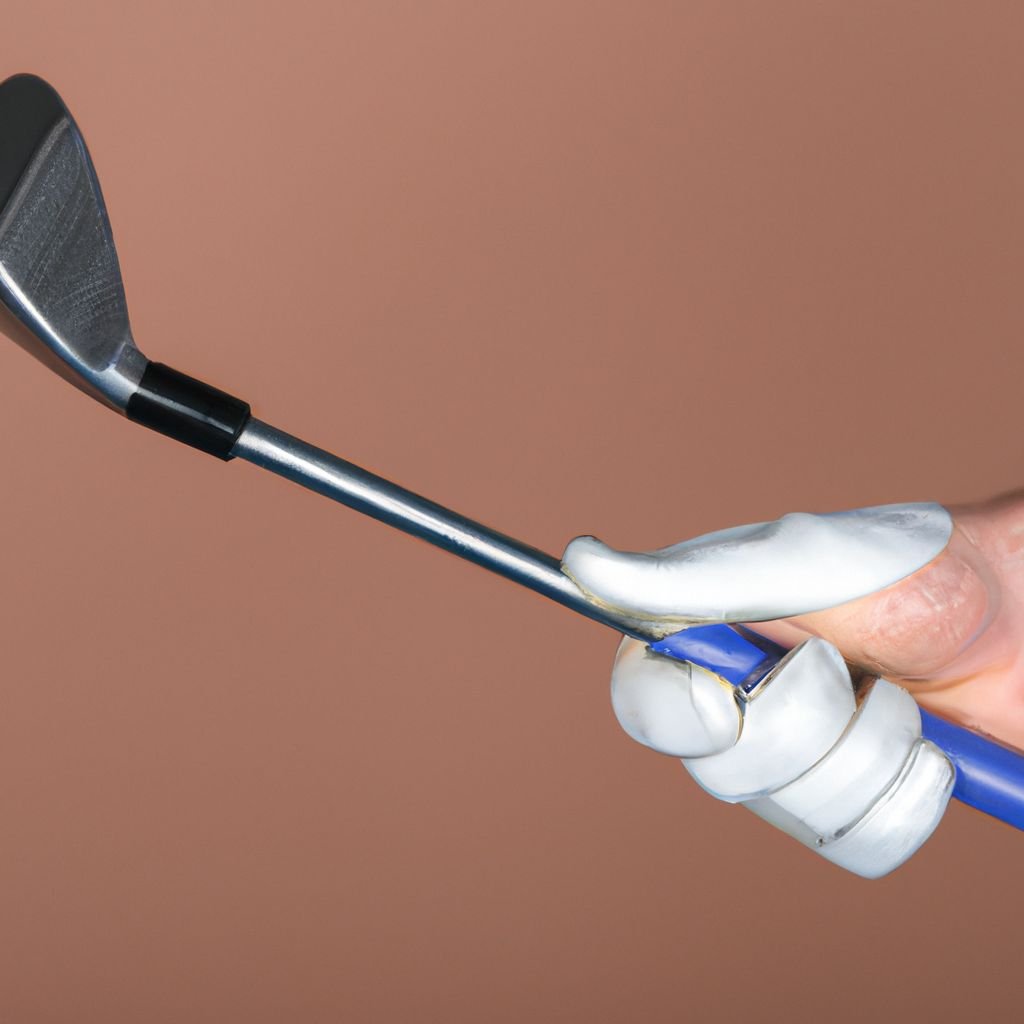


![Master Your Golf Swing with the Perfect Irons: Tips and Tricks [2024]](https://www.fairwayfindings.com/wp-content/uploads/2024/03/Master-Your-Golf-Swing-with-the-Perfect-Irons-768x768.webp)


